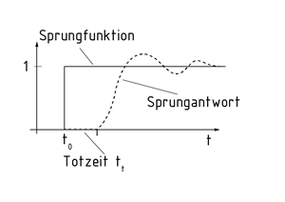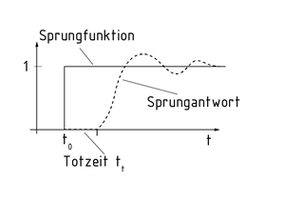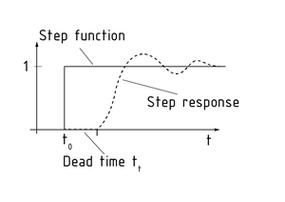
一种定义
四种语言
0,1,2
- 德國
- 英語
- 中國
- 西班牙語
纯滞后元件

在闭环控制技术中,纯滞后时间 ${{T}_{t}}$ 是系统的输入发生变化和系统输出做出响应之间的时间。除了纯滞后时间,系统还使用纯滞后元件的术语。由于有纯滞后元件,进行精确控制会变得更加困难,原则上应避免或最大限度地减小纯滞后时间元件的出现。系统的输出只有在信号经过一定的距离才发生变化,而为此所需的时间就是纯滞后时间。
纯滞后时间不应与延迟时间相混淆。在延迟时间情况下,系统会由于物理现象,如转动惯量,从而在一定时间后做出响应。然而,在所有概率条件下,系统输出的反应会出现变化。而纯滞后时间仅仅指的是传播时间。
这里举一个传送带的纯滞后时间的例子。在系统输入端装载货物后,必须通过整个输送带,才会在系统的输出端(在传送带的末端)发生变化。如果受控系统包括纯滞后元件,该系统有必要使用积分控制器或者比例积分控制器。 而不能使用比例、比例微分,或者比例积分微分控制器。
有纯滞后时间 RC 电路的阶跃响应
近义词
纯滞后时间
Totzeit-Glied

Die Totzeit ${{T}_{t}}$ beschreibt in der Regelungstechnik die Zeit, die nach Änderung des Systemeingangs bis zur Antwort des Systemausganges verstreicht. Neben dem Begriff Totzeit wird oftmals auch der Terminus Totzeitglied benutzt. Totzeitglieder erschweren eine genaue Regelung und sind grundsätzlich zu vermeiden beziehungsweise so gering wie möglich zu halten. Eine Änderung am Systemausgang kommt erst dann zustande, wenn eine bestimmte Strecke durchlaufen wurde. Die dafür benötigte Zeit ist die Totzeit.
Totzeiten sollten dabei nicht mit Verzögerungszeiten verwechselt werden. Bei einer Verzögerungszeit reagiert ein System nach einer bestimmten Zeit aufgrund physikalischer Phänomene wie der Massenträgheit. Die Antwort am Systemausgang ändert sich dabei aber sehr wohl. Totzeiten sind immer Laufzeiten.
Beispiel der Totzeit eines Transportbandes: Am Eingang des Systems wird ein Warenstrom aufgeladen. Bis sich am Systemausgang (am Ende des Förderbandes) eine Änderung einstellt, muss die Ware zunächst das gesamte Förderband durchlaufen. Sofern eine Regelstrecke durch ein reines Totzeitglied gegeben ist, wird der Einsatz eines I- oder PI-Reglers notwendig. P-, PD- und PID-Regler sind für diese Anwendung unbrauchbar.
Dead-time element

In closed-loop control technology, the dead time ${{T}_{t}}$ is the time between changing the system input and the system output's response. In addition to dead time, the term dead-time element is also used. Dead-time elements make precise control more difficult and should, in principle, be avoided or minimised. The system output only changes once a certain distance has been covered. The time required for this is the dead time.
Dead times should not be confused with delay times. In the case of a delay time, a system responds after a certain time due to physical phenomena such as the mass moment of inertia. However, the response at the system output in all probability changes. Dead times are always propagation times.
Take the example of the dead time of a conveyor belt. Goods are loaded at the system input and must pass along the entire conveyor belt before a change occurs at the system output (at the end of the conveyor belt). If a Controlled system comprises a pure dead-time element, it is necessary to use an I or PI controller. P, PD and PID controllers cannot be used for this application.
Elemento de tiempo muerto

En la tecnología de control de bucle cerrado, el tiempo muerto ${{T}_{t}}$ es el tiempo entre el cambio de la entrada del sistema y la respuesta de la salida del sistema. Además del tiempo muerto, también se usa el término elemento de tiempo muerto. Los elementos de tiempo muerto dificultan un control preciso y deben, en principio, ser evitados o minimizados. La salida del sistema solo cambia una vez que cierta distancia ha sido cubierta. El tiempo requerido para esto es el tiempo muerto.
Los tiempos muertos no se deben confundir con tiempos de retraso. En el caso de un tiempo de retraso, el sistema responde después de un cierto tiempo debido a un fenómeno físico como el momento de inercia de masa. Sin embargo, la respuesta en la salida del sistema en toda probabilidad cambia. Los tiempos muertos siempre son tiempos de propagación.
Tomemos por ejemplo el tiempo muerto de una banda transportadora. Los artículos son cargados en la entrada del sistema y deben pasar por toda la banda transportadora antes de que ocurra un cambio en la salida del sistema (en el final de la banda transportadora). Si un sistema controlado comprende de un elemento de tiempo muerto puro, se debe usar un controlador I o PI. Los controladores P, PD y PID no pueden usarse para esta aplicación.
Respuesta de paso para un circuito RC con tiempo muerto
